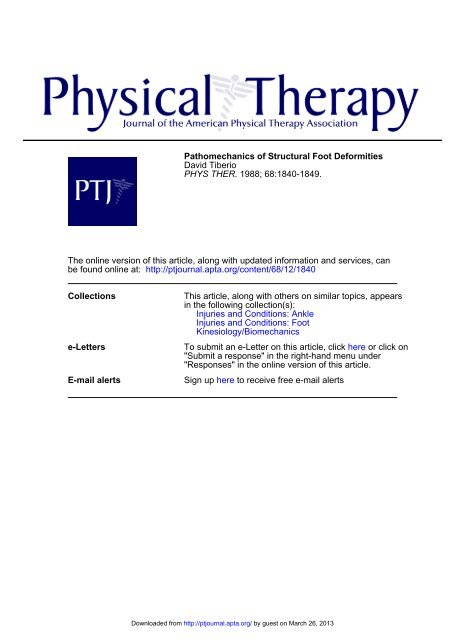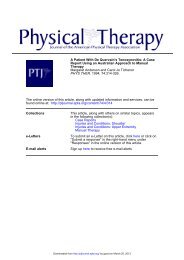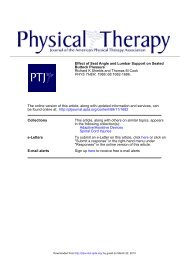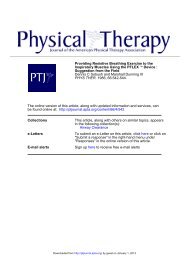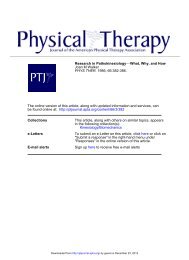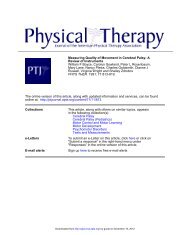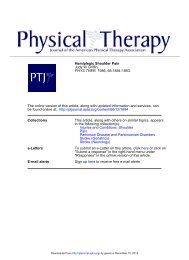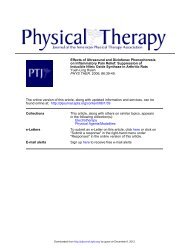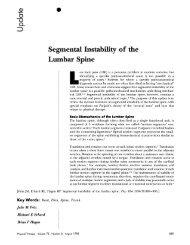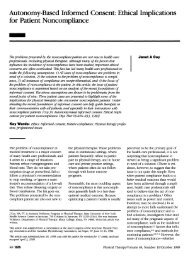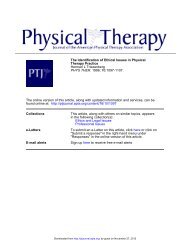Pathomechanics of Structural Foot Deformities - Physical Therapy
Pathomechanics of Structural Foot Deformities - Physical Therapy
Pathomechanics of Structural Foot Deformities - Physical Therapy
You also want an ePaper? Increase the reach of your titles
YUMPU automatically turns print PDFs into web optimized ePapers that Google loves.
<strong>Pathomechanics</strong> <strong>of</strong> <strong>Structural</strong> <strong>Foot</strong> <strong>Deformities</strong><br />
David Tiberio<br />
PHYS THER. 1988; 68:1840-1849.<br />
The online version <strong>of</strong> this article, along with updated information and services, can<br />
be found online at: http://ptjournal.apta.org/content/68/12/1840<br />
Collections<br />
e-Letters<br />
This article, along with others on similar topics, appears<br />
in the following collection(s):<br />
Injuries and Conditions: Ankle<br />
Injuries and Conditions: <strong>Foot</strong><br />
Kinesiology/Biomechanics<br />
To submit an e-Letter on this article, click here or click on<br />
"Submit a response" in the right-hand menu under<br />
"Responses" in the online version <strong>of</strong> this article.<br />
E-mail alerts Sign up here to receive free e-mail alerts<br />
Downloaded from<br />
http://ptjournal.apta.org/ by guest on March 26, 2013
<strong>Pathomechanics</strong> <strong>of</strong> <strong>Structural</strong> <strong>Foot</strong> <strong>Deformities</strong><br />
DAVID TIBERIO<br />
This article presents the most common structural foot deformities encountered<br />
in clinical practice. The deformities are defined, and the expected compensations<br />
at the subtalar joint (STJ) are described. The theoretical consequences <strong>of</strong> the<br />
STJ compensations on proximal and distal tissues are presented. A biomechanical<br />
rationale for certain tissue disorders is described. The possible effects <strong>of</strong><br />
abnormal STJ compensation on osseous development are briefly discussed.<br />
Key Words: <strong>Foot</strong> deformities; Gait; Kinesiology/biomechanics, lower extremity;<br />
Lower extremity, ankle and foot; Subtalar joint.<br />
From an anatomical perspective, the foot is a complex<br />
group <strong>of</strong> bones and muscles. The foot is a marvelous structure<br />
when viewed from the perspective <strong>of</strong> biomechanical function.<br />
The foot must perform diverse functions at specific times<br />
during the gait cycle. Other articles in this issue discuss in<br />
detail the anatomy and biomechanical function <strong>of</strong> the foot.<br />
From a practical standpoint, the foot must 1) adapt to the<br />
ground surface and simultaneously facilitate the body's shockabsorbing<br />
mechanism and 2) function as a rigid lever to propel<br />
the body across the ground. 1 The normal (structurally<br />
undeformed) foot is adequately prepared to perform these<br />
functions.<br />
When structural deformities exist in the foot, the subtalar<br />
joint (STJ) is likely to compensate. Although the deformities<br />
usually exist in a single plane, the compensatory motion <strong>of</strong><br />
the STJ occurs in all three cardinal planes. Compensatory<br />
motion <strong>of</strong> the STJ interferes with the foot's ability to accomplish<br />
its primary functions. This article analyzes the anticipated<br />
STJ compensations in response to specific foot deformities.<br />
The effect (<strong>of</strong>ten theoretical) <strong>of</strong> STJ compensation on<br />
both distal and proximal structures will be described. Alternative<br />
compensations for structural foot deformities will also<br />
be discussed.<br />
THE NORMAL FOOT<br />
To understand the pathomechanics <strong>of</strong> foot function, knowledge<br />
must be acquired regarding the various structural foot<br />
deformities that are commonly encountered in clinical practice.<br />
The criteria for a normal foot provide the basis for<br />
identification <strong>of</strong> structural foot deformities. Figure 1 depicts<br />
the structural alignment <strong>of</strong> a normal foot during weightbearing.<br />
When the STJ is in a neutral position (neither pronated<br />
nor supinated), the major components <strong>of</strong> the normal<br />
foot are 1) both plantar condyles <strong>of</strong> the calcaneus are on the<br />
surface, 2) all <strong>of</strong> the metatarsal heads lie in one plane, and 3)<br />
the plane <strong>of</strong> the metatarsal heads is the same plane as the<br />
plantar condyles <strong>of</strong> the calcaneus. 1 In addition, the orientation<br />
<strong>of</strong> the distal third <strong>of</strong> the lower leg should be vertical to position<br />
the foot properly for the stance phase. The orientation <strong>of</strong> the<br />
bones in the normal foot provides the basis for a clinical<br />
D. Tiberio, MS, PT, is Assistant Pr<strong>of</strong>essor, Program in <strong>Physical</strong> <strong>Therapy</strong>,<br />
University <strong>of</strong> Connecticut, School <strong>of</strong> Allied Health Pr<strong>of</strong>essions, PO Box U-101,<br />
358 Mansfield Rd, Storrs, CT 06268 (USA), and Consultant, West Hartford<br />
<strong>Physical</strong> <strong>Therapy</strong>, 29 N Main St, West Hartford, CT, and Director, On-Site<br />
Biomechanical Education and Training, PO Box 34, Storrs, CT 06268.<br />
examination (see article by Giallonardo in this issue). A brief<br />
discussion <strong>of</strong> these evaluation procedures will facilitate the<br />
description <strong>of</strong> specific foot deformities.<br />
Subtalar Joint Neutral<br />
The measurement <strong>of</strong> the STJ neutral position is actually a<br />
measurement <strong>of</strong> the angle between a line that bisects the distal<br />
third <strong>of</strong> the lower leg and a line that bisects the calcaneus<br />
(Fig. 2). 2 The bisection <strong>of</strong> the calcaneus represents the position<br />
<strong>of</strong> the plantar condyles, because the calcaneus is almost<br />
perpendicular to the condyles. The plane <strong>of</strong> the condyles<br />
should be perpendicular to the distal third <strong>of</strong> the leg. The<br />
angle between the bisections, therefore, should be zero degrees<br />
in the normal foot but actually is 2 to 3 degrees <strong>of</strong> varus<br />
(inverted) in most subjects. The slight varus <strong>of</strong> the calcaneal<br />
bisection usually is not apparent, and the calcaneus appears<br />
to be directly in line with the lower leg. 3<br />
Metatarsal Heads<br />
The clinician, while maintaining STJ neutral, must assess<br />
whether all <strong>of</strong> the metatarsal heads are in the same plane. The<br />
second, third, and fourth metatarsal heads are usually in the<br />
same plane unless there has been some trauma or longstanding<br />
structural deviation. <strong>Deformities</strong>, whether structural or<br />
functional, are usually found in the first or fifth metatarsal<br />
heads because each <strong>of</strong> these heads has a separate axis <strong>of</strong><br />
motion (see article by Oatis in this issue). Assessing alignment<br />
<strong>of</strong> the first metatarsal head to the second 4 and the fifth<br />
metatarsal head to the fourth, therefore, becomes clinically<br />
important (Fig. 3).<br />
Forefoot-to-Rear <strong>Foot</strong> Relationship<br />
Once established, the plane <strong>of</strong> the metatarsal heads must<br />
be compared with the plantar surface <strong>of</strong> the calcaneus (forefoot-to-rear<br />
foot relationship). Evaluation <strong>of</strong> this relationship<br />
must be made in each <strong>of</strong> the cardinal planes. For frontal plane<br />
assessment, the calcaneal bisection is commonly used to<br />
compare the heel with the forefoot. The calcaneal bisection is<br />
almost perpendicular to the plantar condyles and, by inference,<br />
should be perpendicular to the plane <strong>of</strong> the metatarsal<br />
heads. If the plane <strong>of</strong> the metatarsal heads is perpendicular to<br />
the bisection <strong>of</strong> the calcaneus, the forefoot-to-rear foot relationship<br />
is normal or "neutral" (Fig. 4). 2<br />
1840 PHYSICAL THERAPY<br />
Downloaded from<br />
http://ptjournal.apta.org/ by guest on March 26, 2013
Fig. 1. <strong>Structural</strong> alignment <strong>of</strong> the normal foot during weight-bearing<br />
(STJ = subtalar joint). (Reprinted by permission <strong>of</strong> On-Site Biomechanical<br />
Education and Training, 1988.)<br />
Fig. 2. Measurement <strong>of</strong> subtalar joint (STJ) neutral position indicating<br />
a slight varus angle in the normal foot. (Reprinted by permission<br />
<strong>of</strong> On-Site Biomechanical Education and Training, 1988.)<br />
Fig. 3. Comparison <strong>of</strong> metatarsal head position. (Reprinted by permission<br />
<strong>of</strong> On-Site Biomechanical Education and Training, 1988.) Fig. 4. Assessment <strong>of</strong> forefoot-to-rear foot relationship in the frontal<br />
plane. The plane <strong>of</strong> the metatarsal heads is perpendicular to the<br />
The relationship <strong>of</strong> the forefoot to the rear foot in the<br />
sagittal plane must also be assessed, because structural deformities<br />
may increase the amount <strong>of</strong> ankle dorsiflexion required<br />
for normal ambulation. An imaginary plane representing<br />
the ground surface is applied to the plantar surface <strong>of</strong><br />
the calcaneus. The metatarsal heads should rest upon this<br />
plane (Fig. 5A). The transverse plane forefoot-to-rear foot<br />
relationship <strong>of</strong> a normal foot requires the forefoot to have the<br />
same longitudinal direction as the rear foot (rectus foot). This<br />
relationship, although difficult to measure, is readily observed<br />
in the STJ neutral position (Fig. 5B).<br />
STRUCTURAL DEFORMITIES<br />
The structural deformities described below are encountered<br />
frequently in clinical practice. The clinical incidence <strong>of</strong> these<br />
deformities probably does not reflect their incidence in the<br />
calcaneal bisection. (Reprinted by permission <strong>of</strong> On-Site Biomechanical<br />
Education and Training, 1988.)<br />
general population, because certain deformities are more<br />
likely than others to produce dysfunction requiring treatment.<br />
Although much <strong>of</strong> what is known about the frequency <strong>of</strong><br />
these deformities is anecdotal, a recent study on a select<br />
population <strong>of</strong> women supports clinical experience. 5 The positions<br />
<strong>of</strong> the bone segments described in this section are with<br />
the STJ in a neutral position. Position changes resulting from<br />
ground-reaction forces will be discussed in the section on<br />
compensation.<br />
The most common structural foot deformity is rear-foot<br />
varus. The most frequent and important component <strong>of</strong> a rearfoot<br />
varus is a calcaneal varus. A calcaneal varus (called a<br />
subtalar varus in the podiatric literature) is an inverted position<br />
<strong>of</strong> the calcaneus. It is caused by a failure <strong>of</strong> the calcaneus<br />
Volume 68 / Number 12, December 1988 1841<br />
Downloaded from<br />
http://ptjournal.apta.org/ by guest on March 26, 2013
Fig. 5. (A) Closed-chain ankle dorslflexion with the calcaneus and the metatarsal heads in the same plane; (B) rectus foot alignment in subtalar<br />
joint neutral position. (Reprinted by permission <strong>of</strong> On-Site Biomechanical Education and Training, 1988.)<br />
to complete the ontogenic derotation during childhood. 2,3,6,7<br />
The clinical implication <strong>of</strong> this incomplete derotation (when<br />
the STJ is in the neutral position) is that the bisection <strong>of</strong> the<br />
calcaneus is inverted, and the medial plantar condyle <strong>of</strong> the<br />
calcaneus is not on the ground (see article by Bernhardt in<br />
this issue). Additionally, if the distal third <strong>of</strong> the tibia approaches<br />
the ground with its distal end inclined medially<br />
(internally), rear-foot varus will be increased. This abnormal<br />
inclination can be produced by a genu varum or a tibial<br />
varum. The combination <strong>of</strong> calcaneal varus and any medial<br />
inclination <strong>of</strong> the tibia produces the total rear-foot varus<br />
(Fig. 6). 2,6<br />
Forefoot varus is an osseous deformity <strong>of</strong> the forefoot. The<br />
forefoot-to-rear foot alignment in the frontal plane is abnormal.<br />
The most probable cause <strong>of</strong> this deformity is insufficient<br />
developmental rotation <strong>of</strong> the head <strong>of</strong> the talus. 2,3,6-8 If the<br />
head <strong>of</strong> the talus fails to rotate completely, the navicular and<br />
first cuneiform will be in a cephalad position, which would<br />
leave the medial side <strong>of</strong> the forefoot higher than the lateral<br />
side. This orientation <strong>of</strong> the metatarsal heads is not perpendicular<br />
to the rear foot and, therefore, fails to produce a<br />
normal (neutral) forefoot-to-rear foot relationship (Fig. 7).<br />
Because the medial side <strong>of</strong> the foot is higher than the lateral<br />
side, the forefoot assumes an inverted, or varus, position;<br />
hence, the name forefoot varus. A forefoot varus is a very<br />
destructive deformity and is encountered frequently in patients<br />
with lower extremity dysfunction, despite a relatively<br />
low incidence in the general population.<br />
The opposite structural abnormality, forefoot valgus, is<br />
present when the plane <strong>of</strong> the metatarsal head is in an everted,<br />
or valgus, position. Two structural types <strong>of</strong> forefoot valgus<br />
deformities exist: 1) All <strong>of</strong> the metatarsal heads may be<br />
everted, or 2) the first metatarsal head may be plantar flexed<br />
while the second to fifth metatarsal heads lie in the appropriate<br />
plane (Fig. 8). 7 Excessive ontogenic rotation <strong>of</strong> the talar head<br />
has been proposed as a possible cause <strong>of</strong> forefoot valgus. 6,9<br />
Forefoot valgus may be more common than previously<br />
reported. 5<br />
Forefoot equinus is also a forefoot deformity but occurs in<br />
the sagittal plane. The plane across the metatarsal heads,<br />
although possibly perpendicular to the calcaneal bisection,<br />
does not lie in the same plane as the plantar condyles <strong>of</strong> the<br />
calcaneus (Fig. 9). 10 The metatarsals lie below the calcaneus,<br />
and, therefore, the forefoot structure is plantar flexed when<br />
compared with the rear foot.<br />
MANIFESTATIONS OF ABNORMAL<br />
FOOT MECHANICS<br />
Determination that a structural foot deformity exists is not<br />
a sufficient basis for providing treatment. Treatment is dictated<br />
by the STJ compensations that may occur secondary to<br />
the deformities. The STJ compensation, more than the deformity,<br />
produces the deleterious effects on the musculoskeletal<br />
system. Abnormal foot mechanics are manifested in three<br />
general ways during dynamic function (G. W. Gray, personal<br />
communication, January 1985). 1 The amount, speed, or timing<br />
<strong>of</strong> STJ motion may be abnormal.<br />
Motion is abnormal if the excursion through which the<br />
1842 PHYSICAL THERAPY<br />
Downloaded from<br />
http://ptjournal.apta.org/ by guest on March 26, 2013
Fig. 6. Rear-foot varus: (A) calcaneal varus; (B) combined calcaneal varus and tibial varum; (C) weight-bearing position after subtalar joint (STJ)<br />
compensation. (Reprinted by permission <strong>of</strong> On-Site Biomechanical Education and Training, 1988.)<br />
joint moves is larger or smaller than normal excursion. Too<br />
much motion <strong>of</strong> a joint can create a number <strong>of</strong> challenges to<br />
the musculoskeletal tissues. The muscle-tendon units may<br />
become overstressed while trying to decelerate or control the<br />
excessive motion. Excessive motion may reach the limits <strong>of</strong><br />
joint excursion and stress the noncontractile tissue <strong>of</strong> the joint<br />
(capsule and ligaments). Too little motion <strong>of</strong> the STJ, however,<br />
tends to reduce dissipation <strong>of</strong> ground-reaction forces<br />
and may increase the forces applied to the articular surfaces<br />
<strong>of</strong> the joint.<br />
The second manifestation—speed—is generally a problem<br />
<strong>of</strong> motion occurring too quickly. Increased speed <strong>of</strong> motion<br />
may stress the muscle-tendon unit. Excessive stress in the<br />
tendon is particularly likely to occur during eccentric contractions<br />
as the muscles attempt to decelerate joint motion. The<br />
maximum tension in the tendon is greater during eccentric<br />
contractions because <strong>of</strong> the series elastic component. In addition,<br />
under controlled conditions, the tension increases as<br />
the speed <strong>of</strong> motion increases during eccentric contractions. 11<br />
The third manifestation <strong>of</strong> abnormal foot mechanics is the<br />
disruption <strong>of</strong> the temporal sequence <strong>of</strong> joint motion. When<br />
the STJ pronates or supinates at the wrong time, normal foot<br />
functions may be compromised. In addition, the poorly timed<br />
motion may disrupt the synchronous action <strong>of</strong> the joints <strong>of</strong><br />
the entire lower quarter. As a result, excessive stress may be<br />
placed on the forefoot during propulsion or on the supporting<br />
structures <strong>of</strong> the proximal joints.<br />
Subtalar Joint Compensation for<br />
<strong>Structural</strong> <strong>Deformities</strong><br />
<strong>Structural</strong> foot deformities would make human locomotion<br />
difficult, if not impossible, if the foot were a rigid structure.<br />
The foot is able to compensate for these structural deformities<br />
through the motion <strong>of</strong> the STJ and the midtarsal joint (MTJ).<br />
The functional problem created by structural deformities is<br />
that the foot does not rest securely on the ground surface. For<br />
the foot to acquire stable ground contact, the STJ usually will<br />
attempt to compensate for these deformities. 1,12 The motion<br />
<strong>of</strong> the STJ occurs primarily in the frontal and transverse<br />
planes, allowing the STJ to effectively compensate for structural<br />
deformities in the frontal plane (ie, varus and valgus).<br />
Initially, STJ compensations would appear to be beneficial<br />
because they allow for relatively normal locomotion, particularly<br />
when the foot must adjust for variability in the ground<br />
contour. When the compensation is a constant occurrence<br />
secondary to structural foot deformities, however, it becomes<br />
abnormal. 1 Abnormal STJ compensation may eventually create<br />
enough stress on tissues that symptoms are generated.<br />
Symptoms may occur anywhere in the lower quarter, but the<br />
deleterious effects resulting from specific foot deformities can<br />
be anticipated if the STJ compensations are understood.<br />
Rear-foot Varus<br />
At heel-strike, the STJ is slightly supinated, and the lower<br />
limb is adducted. As a result, the calcaneus is inverted, and<br />
Volume 68 / Number 12, December 1988 1843<br />
Downloaded from<br />
http://ptjournal.apta.org/ by guest on March 26, 2013
Fig. 7. Forefoot varus: (A) forefoot inverted (varus) relative to a normal calcaneus; (B) weight-bearing position after subtalar joint (STJ)<br />
compensation. (Reprinted by permission <strong>of</strong> On-Site Biomechanical Education and Training, 1988.)<br />
ground contact occurs on the lateral aspect. The practical<br />
significance <strong>of</strong> a rear-foot varus is that at heel-strike the<br />
calcaneus is inverted more than normal, and the medial<br />
condyle <strong>of</strong> the calcaneus is farther from the ground (Figs. 6A,<br />
6B). To bring the medial side <strong>of</strong> the foot to the ground, the<br />
calcaneus must evert. Eversion <strong>of</strong> the calcaneus is produced<br />
by STJ pronation, because eversion is a single-plane component<br />
<strong>of</strong> pronation. The STJ goes through an abnormal<br />
amount <strong>of</strong> pronation in compensating for the rear-foot varus<br />
(Fig. 6C). 2,13 Not only is the amount <strong>of</strong> motion too much, but<br />
motion probably will occur too rapidly. An abnormal temporal<br />
sequencing, the third manifestation, is not relevant to a<br />
rear-foot varus because the STJ motion follows the normal<br />
pattern <strong>of</strong> pronation during the contact phase and supination<br />
during mid-stance and propulsion.<br />
The deleterious effects experienced by the forefoot as a<br />
result <strong>of</strong> abnormal STJ pronation secondary to a rear-foot<br />
varus are frequently insignificant. Distal foot symptoms may<br />
result if the degree <strong>of</strong> rear-foot varus is large or if the patient<br />
is involved in work or sports activities that increase the tissue<br />
stresses. When the rear-foot varus is large, the MTJ and the<br />
forefoot may be excessively mobile when the heel rises from<br />
the ground during propulsion. In the normal foot, the STJ<br />
passes from a pronated to a supinated position just before<br />
heel rise. Movement <strong>of</strong> the STJ into a supinated position<br />
reduces the mobility <strong>of</strong> the MTJ ("locks" the MTJ). 14 When<br />
the rear-foot varus is large, although the STJ is moving toward<br />
a supinated position, the foot may not become rigid until<br />
after the heel rises. Whenever propulsion occurs before the<br />
foot has been locked by a supinated position <strong>of</strong> the STJ,<br />
forefoot symptoms and tissue trauma are likely to occur,<br />
because the bones are not properly stabilized. Tissue disorders<br />
include plantar fasciitis (see article by Riddle and Freeman in<br />
this issue), metatarsalgia or stress fractures <strong>of</strong> the second ray,<br />
and hallux abducto valgus. All <strong>of</strong> these tissue disorders are<br />
more likely to occur with a forefoot varus; therefore, the<br />
biomechanical causes will be discussed with that structural<br />
deformity.<br />
Callus formation on the bottom <strong>of</strong> the foot can be considered<br />
a distal effect <strong>of</strong> abnormal foot mechanics. Calluses are<br />
the body's way <strong>of</strong> protecting the skin from excessive shearing<br />
forces between the underlying bones and the insole <strong>of</strong> the<br />
shoe. An ulcer will form instead <strong>of</strong> a callus with certain<br />
diseases that compromise the body's protective mechanism<br />
(see article by Sims et al in this issue). In many instances,<br />
calluses form in clearly identifiable patterns that indicate how<br />
the foot is functioning. 1,15 When specific foot deformities<br />
produce the anticipated STJ compensation, characteristic callus<br />
patterns will form.<br />
In response to a rear-foot varus, a callus will form under<br />
the second metatarsal head and to a lesser degree under the<br />
third and fourth metatarsal heads. 15 The biomechanical reason<br />
for calluses in this location is the fact that the metatarsal<br />
heads move across the skin because the foot is not fully<br />
stabilized when propulsion begins. The callus does not occur<br />
under the first metatarsal head because its stability depends<br />
1844 PHYSICAL THERAPY<br />
Downloaded from<br />
http://ptjournal.apta.org/ by guest on March 26, 2013
Fig. 8. Forefoot valgus: (A) all metatarsal heads everted (valgus); (B) valgus secondary to a plantar-flexed first ray; (C) weight-bearing position<br />
after subtalar joint (STJ) compensation for a rigid forefoot valgus. (Reprinted by permission <strong>of</strong> On-Site Biomechanical Education and Training,<br />
1988.)<br />
on a contraction <strong>of</strong> the peroneus longus muscle. A pronated<br />
foot decreases the mechanical advantage <strong>of</strong> the peroneus<br />
longus muscle. The first metatarsal is unstable (hypermobile),<br />
and the second metatarsal suffers the consequences. In addition,<br />
a callus may form on the medial side <strong>of</strong> the distal phalanx<br />
<strong>of</strong> the hallux. A callus in this location is called a pinch callus,<br />
because it forms when the medial side <strong>of</strong> the hallux rubs<br />
against the inside <strong>of</strong> the shoe. A pinch callus frequently occurs<br />
when an individual propels <strong>of</strong>f <strong>of</strong> an abducted forefoot. The<br />
abducted position <strong>of</strong> the forefoot is created when the STJ is<br />
still pronated as the heel leaves the ground. A pinch callus<br />
forms when the calcaneal varus is large but is seen more<br />
commonly with a forefoot varus or with lateral rotation<br />
deformities <strong>of</strong> the leg.<br />
The proximal effects <strong>of</strong> STJ compensation for a rear-foot<br />
varus are substantial. The extra pronation that is occurring<br />
too quickly during the contact phase <strong>of</strong> gait puts a tremendous<br />
stress on the muscles that decelerate STJ pronation, primarily<br />
the tibialis posterior muscle. The tensile forces in the tendon<br />
during the eccentric contraction are increased by the speed <strong>of</strong><br />
motion. 11,16 Symptoms <strong>of</strong> overuse may occur in the tibialis<br />
posterior muscle 1) at the distal attachment <strong>of</strong> the tendon to<br />
the navicular and first cuneiform, 2) in the tendon sheath as<br />
the tendon glides around the medial malleolus, or 3) at the<br />
proximal attachment <strong>of</strong> the muscle to the bones <strong>of</strong> the lower<br />
leg. This last site is the most frequent source <strong>of</strong> symptoms.<br />
The specific tissue problem has been described as periostitis,<br />
or tearing away <strong>of</strong> the muscle fibers where they attach to the<br />
upper half <strong>of</strong> the tibia.<br />
In addition to the extreme stress placed upon the tibialis<br />
posterior muscle, abnormal STJ pronation may produce excessive<br />
medial rotation <strong>of</strong> the lower leg. Because <strong>of</strong> the obligatory<br />
relationship between STJ motion and lower leg rotation,<br />
whenever the STJ pronates during weight-bearing, the lower<br />
leg must medially rotate. 1,14,17 The extra rotation must be<br />
absorbed in the knee, hip, or sacroiliac joint (SIJ) or between<br />
vertebral segments, and in some individuals may become<br />
symptomatic. In addition, the frontal-plane component <strong>of</strong><br />
abnormal STJ pronation increases the valgus stress on the<br />
knee. Occasionally, this valgus stress exceeds the threshold <strong>of</strong><br />
the medial stabilizing structures <strong>of</strong> the knee, and symptoms<br />
<strong>of</strong> a mild strain (Grade I) <strong>of</strong> the medial collateral ligament<br />
will arise.<br />
Although abnormal STJ pronation is the most frequent<br />
compensation for a rear-foot varus, alternative compensations<br />
may occur. Partial compensation has occurred if the STJ<br />
pronates abnormally but does not have enough available<br />
pronation range <strong>of</strong> motion to bring the medial condyle <strong>of</strong> the<br />
calcaneus to the ground. The foot must find another way to<br />
bring the medial side <strong>of</strong> the foot to the ground. 18 The rear<br />
Volume 68 / Number 12, December 1988 1845<br />
Downloaded from<br />
http://ptjournal.apta.org/ by guest on March 26, 2013
Fig. 9. Forefoot equinus: (A) forefoot plantar flexed relative to the rear foot; (B) increased dorsiflexion at the ankle in weight-bearing position.<br />
(Reprinted by permission <strong>of</strong> On-Site Biomechanical Education and Training, 1988.)<br />
foot will usually achieve full-surface contact through a wedging<br />
<strong>of</strong> the heel pad from weight-bearing forces. Medial forefoot<br />
contact can be achieved by MTJ pronation or plantar flexion<br />
<strong>of</strong> the first ray (partial compensations). This latter compensation<br />
may alter the callus pattern slightly by creating a small<br />
callus under the first metatarsal head.<br />
There are instances when the STJ fails to compensate by<br />
pronating. This failure results in an uncompensated rear-foot<br />
varus with callus formation, which is greatest under the<br />
fifth metatarsal head. 15 The symptoms resulting from an<br />
uncompensated varus would be different. Because the STJ<br />
fails to pronate, the foot does not facilitate the normal shockabsorbing<br />
mechanism at the knee. An uncompensated varus<br />
is more common with a forefoot varus.<br />
Forefoot Varus<br />
The foot with a structural forefoot varus has a normal<br />
calcaneus that is parallel to the ground when the STJ is in the<br />
neutral position (Fig. 7A). When the lateral border <strong>of</strong> the heel<br />
strikes the ground, therefore, a normal amount <strong>of</strong> STJ pronation<br />
occurs. When the medial condyle reaches the ground,<br />
the STJ should reverse its direction and begin supinating.<br />
With a forefoot varus, however, the medial side <strong>of</strong> the forefoot<br />
is not touching the ground. To assist the medial side <strong>of</strong> the<br />
forefoot in reaching the ground, the STJ may pronate as the<br />
mid-stance phase begins (Fig. 7B). 7,12,13 This pronation is<br />
abnormal because it is excessive and because it is occurring<br />
at the wrong time. A forefoot varus, therefore, will manifest<br />
itself in an excessive amount <strong>of</strong> pronation combined with<br />
abnormal temporal sequencing. The STJ compensates for a<br />
forefoot varus by pronating abnormally like a rear-foot varus,<br />
but unlike a rear-foot varus, the pronation occurs during the<br />
mid-stance and propulsion phases.<br />
As a result <strong>of</strong> this compensatory pronation <strong>of</strong> the STJ<br />
during the mid-stance phase, the MTJ becomes maximally<br />
mobile at the time when a normal foot would be reaching a<br />
supinated position just before propulsion. 1,14,19 The MTJ remains<br />
unlocked throughout propulsion, creating extreme<br />
stresses on the tissue in the forefoot. The plantar fascia, which<br />
tightens via the "windlass" effect when the heel rises, 14,20<br />
experiences an inordinate amount <strong>of</strong> stress in attempting to<br />
support the arch <strong>of</strong> the foot (see article by Riddle and Freeman<br />
in this issue). In the normal foot, the mobility in the MTJ is<br />
reduced and the mechanical advantage <strong>of</strong> the muscles is<br />
enhanced when the STJ is in a supinated position. 1,21 When<br />
propulsion takes place <strong>of</strong>f <strong>of</strong> a pronated foot, these normal<br />
stabilizing mechanisms are lost. The plantar fascia must attempt<br />
to support the arch alone and at some point may<br />
become symptomatic.<br />
The first ray is unstable (hypermobile) with a compensated<br />
forefoot varus. 1 The ligamentous and muscular stabilizers are<br />
ineffective because <strong>of</strong> the pronated position in the STJ. The<br />
second metatarsal head will experience excessive loading be-<br />
1846 PHYSICAL THERAPY<br />
Downloaded from<br />
http://ptjournal.apta.org/ by guest on March 26, 2013
cause the first ray-hallux complex cannot effectively contribute<br />
to propulsion. The resultant metatarsalgia or stress fracture<br />
<strong>of</strong> the second metatarsal is not difficult to anticipate.<br />
Another distal effect commonly encountered with a forefoot<br />
varus is the development <strong>of</strong> a hallux abductovalgus<br />
deformity (HAV bunion). 1,12 The biomechanical basis <strong>of</strong> this<br />
deformity is multifactorial, but propulsion <strong>of</strong>f <strong>of</strong> a forefoot<br />
that is abducted as a result <strong>of</strong> abnormal pronation is frequently<br />
the underlying catalyst. 1 Clinical observation <strong>of</strong> gait in patients<br />
with a HAV deformity readily reveals the abnormal<br />
forces on the hallux during the propulsion phase. The groundreaction<br />
forces pass along the side <strong>of</strong> the hallux and combine<br />
with the hypermobility <strong>of</strong> the first ray to produce a long-term<br />
structural change in the first metatarsophalangeal (MTP)<br />
joint. These three clinical problems in the distal foot, and<br />
countless other problems, result from propulsion <strong>of</strong>f <strong>of</strong> a<br />
hypermobile foot. As with rear-foot varus, the callus formation<br />
will be primarily under the second metatarsal head. The<br />
callus formation is <strong>of</strong>ten extreme, and the pinch callus is<br />
almost always present because the foot remains abnormally<br />
pronated throughout the propulsion phase. 12,15<br />
The proximal effects <strong>of</strong> a forefoot varus frequently produce<br />
tissue symptoms. The severity <strong>of</strong> these proximal stresses is<br />
due to the fact that the STJ pronation is occurring at the<br />
wrong time. Pronation occurs when the STJ should be supinating<br />
and the lower leg should be rotating laterally. This<br />
lateral rotation <strong>of</strong> the lower leg is essential for the synchronous<br />
action <strong>of</strong> the knee, hip, and pelvis. If the lateral rotation that<br />
accompanies STJ supination is not present, the synchrony is<br />
disrupted, and the lower extremity must find some way to<br />
adjust. During the mid-stance phase when the STJ is pronating<br />
abnormally, the knee is moving toward terminal extension.<br />
Terminal extension requires the tibia to laterally rotate<br />
on the femur. With a forefoot varus, the abnormal pronation<br />
during mid-stance denies the knee <strong>of</strong> the necessary medial<br />
rotation and creates a biomechanical dilemma for the knee. 22<br />
The knee cannot extend without the rotation; if it attempts<br />
to do so, the supporting structures <strong>of</strong> the knee may be<br />
traumatized.<br />
If the knee joint avoids this dilemma by having the femur<br />
rotate medially with the tibia, the problem is transferred to a<br />
more proximal structure. If the poorly timed rotation is<br />
absorbed at the hip joint, a piriformis muscle syndrome or<br />
SIJ dysfunction could result. The piriformis muscle laterally<br />
rotates the femur. During closed-chain dynamic function, the<br />
piriformis muscle decelerates the medial rotation <strong>of</strong> the femur<br />
on the pelvis. The piriformis muscle affects the SIJ by virtue<br />
<strong>of</strong> its attachment to the anterior aspect <strong>of</strong> the sacrum. During<br />
the mid-stance phase, the pelvis reverses direction to move<br />
forward with the swinging leg. If the femur medially rotates<br />
secondary to the forefoot varus, the bony attachments <strong>of</strong> the<br />
piriformis muscle will be pulled in opposite directions, increasing<br />
stress to both contractile and noncontractile tissues.<br />
Stress would be transferred to the lumbosacral spine if the<br />
pelvis were to compensate by moving with the femur. Symptoms,<br />
therefore, can develop anywhere along the lower extremity<br />
chain, especially where predisposing factors make<br />
tissues susceptible to failure.<br />
As was mentioned with rear-foot varus, the STJ may fail to<br />
compensate for a structural abnormality. 18 In the case <strong>of</strong> a<br />
forefoot varus, the STJ may have only enough ROM, once<br />
the calcaneus is on the ground, to partially compensate for<br />
the forefoot varus. Residual compensation for the forefoot<br />
varus usually occurs at the MTJ (pronation) or at the first ray<br />
(plantar flexion). The STJ may not compensate for the forefoot<br />
varus at all. If the STJ does not pronate, the mobility <strong>of</strong><br />
the MTJ is restricted, and the patient would exhibit an uncompensated<br />
forefoot varus. Weight is borne primarily on the<br />
lateral border <strong>of</strong> the foot, producing the characteristic callus<br />
under the fifth metatarsal head. 15 The symptoms <strong>of</strong> an uncompensated<br />
varus may be focused on the lateral border <strong>of</strong><br />
the foot. Proximal synchrony is not disrupted during the midstance<br />
phase when the forefoot varus is uncompensated.<br />
Instead, the patient's proximal symptoms may be similar to<br />
symptoms produced from a failure to attenuate shock because<br />
the STJ is not pronating enough.<br />
Forefoot Valgus<br />
A forefoot valgus, as described earlier, is a structural deformity<br />
that occurs when the forefoot is everted relative to<br />
the rear foot, bringing the medial side <strong>of</strong> the foot below the<br />
lateral side (Figs. 8A, 8B). To understand the pathomechanical<br />
manifestations <strong>of</strong> this foot type, a differentiation must be<br />
made between a flexible forefoot valgus and a rigid forefoot<br />
valgus. 7 A flexible valgus usually develops secondary to an<br />
uncompensated or partially compensated rear-foot varus. A<br />
flexible forefoot valgus, therefore, will be discussed in the<br />
section on combined foot types. The remainder <strong>of</strong> this section<br />
will focus on a forefoot valgus that is rigid and that cannot be<br />
eliminated when the ground-reaction force pushes against the<br />
foot during standing. 4<br />
If no STJ compensation occurs in response to a forefoot<br />
valgus, all <strong>of</strong> the body weight would be borne on the medial<br />
side <strong>of</strong> the forefoot. The foot would be relatively unstable.<br />
Achieving stability by bringing the lateral side <strong>of</strong> the foot to<br />
the ground is accomplished by STJ supination. 6,8,13 As the<br />
STJ begins to move from a supinated to a pronated position<br />
at heel-strike, the medial side <strong>of</strong> the forefoot strikes the<br />
ground, forcing the STJ back into a supinated position (Fig.<br />
8C). This supination prevents the normal STJ pronation<br />
during the contact phase. The manifestation <strong>of</strong> a rigid forefoot<br />
valgus, therefore, is a foot that exhibits too little pronation<br />
and then returns to a supinated position much sooner than<br />
would a normal foot. 4<br />
One <strong>of</strong> the distal effects <strong>of</strong> the abnormally supinated foot<br />
is that the MTJ never attains the mobility required for the<br />
foot to adapt to the ground. The rigid foot has difficulty<br />
moving across uneven terrain. A foot with a forefoot valgus<br />
also is very susceptible to lateral inversion (supination) ankle<br />
sprains. The STJ is supinated when this foot is on the ground<br />
in its compensated position, creating a situation where the<br />
STJ is much closer to the end <strong>of</strong> the ROM than it would be<br />
in a normal foot (Fig. 8C). The proximity to the end <strong>of</strong> the<br />
ROM reduces the amount <strong>of</strong> time that the muscles have to<br />
contract to prevent a lateral ankle sprain. Additionally, because<br />
the MTJ and the rest <strong>of</strong> the foot are hypomobile, the<br />
effect <strong>of</strong> any object or undulation under the forefoot will<br />
immediately be transferred to the STJ, increasing the likelihood<br />
<strong>of</strong> ligamentous injury.<br />
Other distal effects involve the first ray and hallux. If the<br />
forefoot valgus results from a rigid plantar-flexed position <strong>of</strong><br />
the first ray, then the normal motion <strong>of</strong> the first MTP joint<br />
during locomotion may be compromised (Fig. 8B). As the<br />
heel rises from the ground during propulsion, the MTP joint<br />
must have 65 to 70 degrees <strong>of</strong> dorsiflexion. 1 For this amount<br />
<strong>of</strong> dorsiflexion to occur, the first ray must plantar flex more<br />
than the second ray during the propulsive sequence. If the<br />
Volume 68 / Number 12, December 1988 1847<br />
Downloaded from<br />
http://ptjournal.apta.org/ by guest on March 26, 2013
first ray is plantar flexed and rigid, it frequently is unable to<br />
plantar flex further to supply the first MTP joint with the<br />
necessary dorsiflexion. Failure to plantar flex alters the arthrokinematics<br />
<strong>of</strong> the first MTP joint and in some cases will<br />
lead to the degenerative changes that produce hallux limitusrigidus.<br />
1,13 Callus formation in the rigid forefoot valgus occurs<br />
under the first and fifth metatarsal heads. 15 The callus under<br />
the first metatarsal head will be accentuated when the forefoot<br />
valgus is the result <strong>of</strong> a plantar-flexed first ray.<br />
The proximal effects <strong>of</strong> a compensated forefoot valgus lie<br />
primarily in the fact that the shock-absorbing ability <strong>of</strong> the<br />
knee is compromised. 1,2 The STJ fails to pronate, thereby<br />
denying the knee the medial rotation <strong>of</strong> the lower leg required<br />
for flexion. Knee flexion during the contact phase is delayed<br />
for a short time. This delay allows increased forces to travel<br />
up the lower extremity. The increased forces may contribute<br />
to the development <strong>of</strong> central patell<strong>of</strong>emoral pain or sacral<br />
and low back dysfunction. The supinated position <strong>of</strong> the STJ<br />
also increases the varus stress on the knee and may be a factor<br />
in the development <strong>of</strong> problems around the lateral aspect <strong>of</strong><br />
the knee.<br />
The ways for the body to compensate for a rigid forefoot<br />
valgus, other than abnormal STJ supination, are limited.<br />
These alternative mechanisms are usually activated during<br />
propulsion. The normal shift <strong>of</strong> the center <strong>of</strong> mass from one<br />
leg to the other becomes difficult because <strong>of</strong> the failure <strong>of</strong> the<br />
STJ to pronate. The normal lateral-to-medial weight transfer<br />
across the forefoot during propulsion may be accomplished<br />
by lifting the lateral border <strong>of</strong> the foot <strong>of</strong>f the ground. 1<br />
Forefoot Equinus<br />
Forefoot equinus is a plantar-flexed position <strong>of</strong> the forefoot<br />
when compared with the rear foot (Fig. 9A). 12 The functional<br />
effect <strong>of</strong> this deformity is that the ankle joint must move<br />
through a greater excursion <strong>of</strong> dorsiflexion to allow the body<br />
to move forward over the foot during the mid-stance phase<br />
(Fig. 9B). If enough ankle joint motion occurs, no additional<br />
compensation is required. If ankle joint motion is insufficient,<br />
compensation will occur elsewhere in the lower extremity.<br />
The STJ is unable to compensate directly for a forefoot<br />
equinus because it has very little motion in the sagittal plane<br />
(dorsiflexion). 10 Other than the ankle joint, the most effective<br />
source <strong>of</strong> dorsiflexion is the MTJ. If the MTJ is to provide<br />
the dorsiflexion to compensate for the forefoot equinus, it<br />
must be mobile. A mobile MTJ is created when the STJ is in<br />
a pronated position. 6 The time when maximum dorsiflexion<br />
is needed at heel rise, however, is also the time when the STJ<br />
should be in a supinated position for propulsion. The abnormal<br />
STJ pronation in the mid-stance phase, as a compensation<br />
for forefoot equinus, may produce clinical symptoms<br />
similar to the distal effects encountered with a compensated<br />
forefoot varus. 10<br />
In many instances, a forefoot equinus occurs in a foot that<br />
also has a rigid forefoot valgus. The compensatory mechanism<br />
described above is not possible because the STJ cannot pronate.<br />
In this case, the compensation and the associated clinical<br />
symptoms are more proximal in the leg. If there is not enough<br />
motion in the sagittal plane (dorsiflexion) at the ankle, then<br />
motion in the sagittal plane may be achieved at the knee<br />
joint. As the body progresses forward over the foot and the<br />
tibia is unable to move forward, a hyperextension force is<br />
created at the knee joint.<br />
Additional stress may occur at the ankle. The tibia, as it<br />
tries to move forward against the resistance <strong>of</strong> the s<strong>of</strong>t tissues,<br />
will produce a change in the normal joint arthrokinematics.<br />
The rolling component <strong>of</strong> the articular motion decreases, and<br />
the neck <strong>of</strong> the talus may contact the anterior lip <strong>of</strong> the tibia.<br />
Repetitive contact on this nonarticular surface may produce<br />
a talar exostosis. 1,13,23 As indicated by these examples, the<br />
clinician should realize that compensatory mechanisms <strong>of</strong>ten<br />
shift the tissue stress from the site <strong>of</strong> the deformity or the site<br />
<strong>of</strong> the compensation.<br />
Combined Rear-foot and Forefoot <strong>Deformities</strong><br />
The common structural foot deformities frequently occur<br />
together. A rear-foot varus can occur with either a forefoot<br />
varus or forefoot valgus. The manifestations <strong>of</strong> the combined<br />
foot deformities may be slightly different from the individual<br />
structural abnormalities. In a foot that exhibits a rear-foot<br />
and a forefoot varus, the abnormal compensatory pronation<br />
at the STJ is accentuated. The STJ pronation is abnormal<br />
throughout the contact, mid-stance, and propulsion phases <strong>of</strong><br />
the gait cycle. The STJ pronates too much and too rapidly<br />
during contact because <strong>of</strong> the rear-foot varus and pronates<br />
too much and at the wrong time because <strong>of</strong> the forefoot varus.<br />
The patient may demonstrate both distal and proximal effects.<br />
The amount <strong>of</strong> obligatory medial rotation <strong>of</strong> the leg that<br />
accompanies the abnormal STJ pronation is extreme. Proximal<br />
dysfunction is more likely to occur with both deformities,<br />
therefore, than with either deformity alone.<br />
A rear-foot varus may also be combined with a flexible<br />
forefoot valgus. The forefoot valgus may have developed<br />
secondary to a partially compensated rear-foot varus. Based<br />
on the description <strong>of</strong> STJ compensation with a rigid forefoot<br />
valgus, it would seem that STJ pronation would be limited.<br />
Clinically, however, this foot type demonstrates a significant<br />
amount <strong>of</strong> pronation during stance. 4,13 As the STJ begins to<br />
pronate, MTJ mobility increases, and the forefoot valgus<br />
becomes flexible. If STJ pronation is not sufficient to bring<br />
the medial side <strong>of</strong> the forefoot to the ground, pronation will<br />
occur at the MTJ. The foot definitely is abnormally pronated,<br />
but the abnormal pronation occurs at the MTJ as well as at<br />
the STJ. Although slight evidence <strong>of</strong> callus formation may<br />
exist under the first metatarsal head, the foot is clearly an<br />
abnormal pronator and will exhibit a pronounced callus under<br />
the second metatarsal head.<br />
The third combination <strong>of</strong> foot deformities occurs when a<br />
rigid forefoot valgus is present with a rear-foot varus. This<br />
combination is not uncommon and creates extreme bone<br />
stress in the middle <strong>of</strong> the foot. As the heel strikes the ground,<br />
the STJ begins to pronate in response to the rear-foot varus.<br />
When the forefoot reaches the ground, the forefoot valgus<br />
begins to take effect. The normal compensation for a forefoot<br />
valgus is STJ supination to get the lateral side <strong>of</strong> the foot to<br />
the ground. The motion <strong>of</strong> the rear foot and forefoot in<br />
opposite directions creates a biomechanical dilemma for the<br />
foot that is not solved easily. This foot is called a torque foot<br />
because <strong>of</strong> the torsional stresses that are inflicted on the tarsal<br />
bones. Degenerative joint changes and tarsal stress fractures<br />
are potential problems, in addition to the lateral ankle sprains<br />
and proximal problems described with a forefoot valgus.<br />
DISCUSSION<br />
Clinical observations and, to a limited degree, research<br />
findings indicate that the STJ is the most frequent site <strong>of</strong><br />
1848 PHYSICAL THERAPY<br />
Downloaded from<br />
http://ptjournal.apta.org/ by guest on March 26, 2013
compensation for structural foot deformities. The STJ compensation<br />
provides the motion needed to minimize the disruption<br />
<strong>of</strong> human locomotion created by the foot deformities.<br />
Many <strong>of</strong> the foot deformities are single-plane deformities, but<br />
the compensatory motion at the STJ or MTJ occurs in more<br />
than one plane. In addition to excessive motion, motion<br />
occurring too rapidly, or motion occurring at the wrong time,<br />
therefore, unnecessary motion occurs in the other cardinal<br />
planes. 1<br />
This article concentrated on abnormal compensations <strong>of</strong><br />
the STJ. Brief mention was made <strong>of</strong> partial and alternative<br />
compensations at the MTJ. The MTJ is responsible for making<br />
adjustments between the forefoot and rear foot consistent<br />
with the foot's function as a mobile adapter. Compensations<br />
for foot deformities that occur at the MTJ are probably better<br />
tolerated than those at the STJ but still hold the potential for<br />
tissue breakdown. Variations in the structural alignment <strong>of</strong><br />
the MTJ in different individuals will alter the specific compensations.<br />
These MTJ compensations have not been described<br />
completely and are beyond the scope <strong>of</strong> this article.<br />
The compensation <strong>of</strong> the STJ (or MTJ) solves the immediate<br />
problem but creates stress on tissues elsewhere in the<br />
lower quarter. This biomechanical transfer <strong>of</strong> stress does not<br />
always produce symptomatic tissue dysfunction. The tissue<br />
may respond by becoming stronger according to Wolffs law.<br />
When the tissue stress exceeds the symptomatic threshold,<br />
however, therapeutic intervention must include treatments<br />
directed at the symptoms, the biomechanical cause <strong>of</strong> the<br />
symptoms, and any predisposing factors that might be contributing<br />
to tissue breakdown.<br />
The abnormal stress that results from the structural foot<br />
abnormalities does not commonly exceed the symptomatic<br />
threshold in young children. The plasticity <strong>of</strong> the musculoskeletal<br />
tissues and the enhanced tissue repair rate combine<br />
to reduce the occurrence <strong>of</strong> symptoms. The plasticity <strong>of</strong> the<br />
musculoskeletal tissues, unfortunately, leaves children susceptible<br />
to the development <strong>of</strong> structural malalignment as a result<br />
<strong>of</strong> abnormal foot mechanics during development. The osseous<br />
development <strong>of</strong> the foot is discussed in the article by Bernhardt<br />
in this issue, but a brief discussion <strong>of</strong> the effects <strong>of</strong><br />
pathomechanics is warranted here.<br />
The criteria that define a normal foot are not present at the<br />
time <strong>of</strong> birth. Both the posterior aspect <strong>of</strong> the calcaneus and<br />
the head <strong>of</strong> the talus must undergo an ontogenic derotation<br />
to achieve normal alignment. Until this derotation is complete<br />
at 8 or 9 years <strong>of</strong> age, most children will have a calcaneal<br />
varus and a forefoot varus, 3 which will cause them to pronate<br />
excessively. Some children exhibit more pronation than can<br />
be attributed to the incomplete development <strong>of</strong> the foot,<br />
which may indicate the presence <strong>of</strong> structural foot deformities.<br />
This abnormal pronation <strong>of</strong>ten is ignored because <strong>of</strong> the lack<br />
<strong>of</strong> symptoms and the expected reduction <strong>of</strong> this pronation<br />
during development. The abnormal amount <strong>of</strong> childhood<br />
pronation will affect the alignment <strong>of</strong> proximal osseous structures.<br />
The abnormal pronation, which increases the valgus<br />
stress on the adult knee, will create a valgus deformity in the<br />
developing knee. In addition, the obligatory medial rotation<br />
that accompanies STJ pronation may inhibit the normal<br />
ontogenic reduction <strong>of</strong> femoral anteversion. The components<br />
<strong>of</strong> "miserable malalignment syndrome" 24 encountered in clinical<br />
practice are probably the product <strong>of</strong> abnormal biomechanical<br />
forces during childhood rather than <strong>of</strong> a chance<br />
association.<br />
Relief from symptomatic tissue stress in adults or facilitation<br />
<strong>of</strong> normal osseous alignment in children requires a<br />
reduction or elimination <strong>of</strong> the abnormal STJ compensation.<br />
The STJ compensations are beneficial mechanisms responding<br />
to structural foot deformities. Attempts to reduce the STJ<br />
compensations, therefore, must be directed at the structural<br />
deformities through the use <strong>of</strong> foot orthoses (see article by<br />
Lockard in this issue).<br />
SUMMARY<br />
The primary structural foot deformities and most common<br />
STJ compensations encountered in clinical practice have been<br />
described. Theoretical mechanisms for increased tissue stress<br />
and symptoms throughout the lower extremity have been<br />
presented. Possible implications on osseous development and<br />
a rationale for the use <strong>of</strong> biomechanical orthoses were discussed<br />
briefly. The specific tissue dysfunctions described in<br />
this article, although commonly encountered in clinical practice,<br />
are but a small portion <strong>of</strong> the problems that arise from<br />
abnormal foot biomechanics.<br />
REFERENCES<br />
1. Root ML, Orien WP, Weed JH: Normal and Abnormal Function <strong>of</strong> the <strong>Foot</strong>.<br />
Los Angeles, CA, Clinical Biomechanics Corp, 1977<br />
2. McPoil TG Jr, Brocato RS: The foot and ankle: Biomechanical evaluation<br />
and treatment. In Gould JA, Davies GJ (eds): Orthopaedic and Sports<br />
<strong>Physical</strong> <strong>Therapy</strong>. St. Louis, MO, C V Mosby Co, 1985, pp 313-341<br />
3. Straus WL: Growth <strong>of</strong> the human foot and its evolutionary significance.<br />
Contrib Embryl Carnegie Institute 19:93, 1927<br />
4. Langer S: Understanding the plantar-flexed first ray. The Langer Group<br />
Newsletter 9(2):4:5,10, 1981<br />
5. McPoil TG Jr, Knecht HG, Schuit D: A survey <strong>of</strong> foot types in normal<br />
females between the ages <strong>of</strong> 18 and 30 years. Journal <strong>of</strong> Orthopaedic and<br />
Sports <strong>Physical</strong> <strong>Therapy</strong> 9:406-409, 1988<br />
6. Sgarlato TE: A Compendium <strong>of</strong> Podiatric Biomechanics. San Francisco,<br />
CA, College <strong>of</strong> Podiatric Medicine, 1977<br />
7. Hunt GC, Brocato RS: Gait and foot pathomechanics. In Hunt GC (ed):<br />
<strong>Physical</strong> <strong>Therapy</strong> <strong>of</strong> the <strong>Foot</strong> and Ankle. New York, NY, Churchill Livingstone<br />
Inc, 1988, pp 39-57<br />
8. Subotnick SI: Biomechanics <strong>of</strong> the subtalar and midtarsal joints. J Am<br />
Podiatr Assoc 65:756-764, 1975<br />
9. Sarrafian SK: Anatomy <strong>of</strong> the <strong>Foot</strong> and Ankle: Descriptive, Topographic,<br />
Functional. Philadelphia, PA, J B Lippincott Co, 1983<br />
10. Bouche RT, Kuwada GT: Equinus deformity in the athlete. The Physician<br />
and Sportsmedicine 12(1):81-91, 1984<br />
11. Stanish WD, Curwin S: Tendinitis: Its Etiology and Treatment. Lexington,<br />
MA, D C Heath & Co, 1984<br />
12. Hlavac HF: Compensated forefoot varus. J Am Podiatr Assoc 60:229-<br />
233, 1970<br />
13. Weissman SD: Radiology <strong>of</strong> the <strong>Foot</strong>. Baltimore, MD, Williams & Wilkins,<br />
1983<br />
14. Inman VT, Ralston HJ, Todd F: Human Walking. Baltimore, MD, Williams<br />
& Wilkins, 1981<br />
15. Gray GW: When the Feet Hit the Ground Everything Changes: Program<br />
Outline and Prepared Notes—A Basic Manual. Toledo, OH, American<br />
<strong>Physical</strong> Rehabilitation Network, 1984<br />
16. Winter DA: Biomechanics <strong>of</strong> Human Movement. New York, NY, John Wiley<br />
&Sons Inc, 1979<br />
17. Wright DG, Desai SM, Henderson WH: Action <strong>of</strong> the subtalar and anklejoint<br />
complex during the stance phase <strong>of</strong> walking. J Bone Joint Surg [Am]<br />
46:361-382, 1964<br />
18. Making the diagnosis: Uncompensation vs partial compensation vs full<br />
compensation. Langer Biomechanics Newsletter 6(1), 1978<br />
19. Manter JT: Movement <strong>of</strong> the subtalar and transverse tarsal joints. Anat<br />
Rec 80:397-410, 1941<br />
20. Hicks JH: The mechanics <strong>of</strong> the foot: 2. The plantar aponeurosis and arch.<br />
J Anat 88:25-30, 1954<br />
21. Close JR, Inman VT, Poor PM, et al: The function <strong>of</strong> the subtalar joint. Clin<br />
Orthop 50:159-179, 1967<br />
22. Tiberio D: The effect <strong>of</strong> excessive subtalar joint pronation on patell<strong>of</strong>emoral<br />
mechanics: A theoretical model. Journal <strong>of</strong> Orthopaedic and Sports <strong>Physical</strong><br />
<strong>Therapy</strong> 9:160-165, 1987<br />
23. Sammarco GJ, Burstein AH, Frankel VH: Biomechanics <strong>of</strong> the ankle: A<br />
kinematic study. Orthop Clin North Am 4:75-96, 1973<br />
24. James SJ: Chondromalacia <strong>of</strong> the patella in the adolescent. In Kennedy<br />
JC (ed): The Injured Adolescent Knee. Baltimore, MD, Williams & Wilkins,<br />
1979, pp 205-251<br />
Volume 68 / Number 12, December 1988 1849<br />
Downloaded from<br />
http://ptjournal.apta.org/ by guest on March 26, 2013
Cited by<br />
<strong>Pathomechanics</strong> <strong>of</strong> <strong>Structural</strong> <strong>Foot</strong> <strong>Deformities</strong><br />
David Tiberio<br />
PHYS THER. 1988; 68:1840-1849.<br />
This article has been cited by 10 HighWire-hosted<br />
articles:<br />
http://ptjournal.apta.org/content/68/12/1840#otherarticles<br />
Subscription http://ptjournal.apta.org/subscriptions/<br />
Information<br />
Permissions and Reprints http://ptjournal.apta.org/site/misc/terms.xhtml<br />
Information for Authors http://ptjournal.apta.org/site/misc/ifora.xhtml<br />
Downloaded from<br />
http://ptjournal.apta.org/ by guest on March 26, 2013


